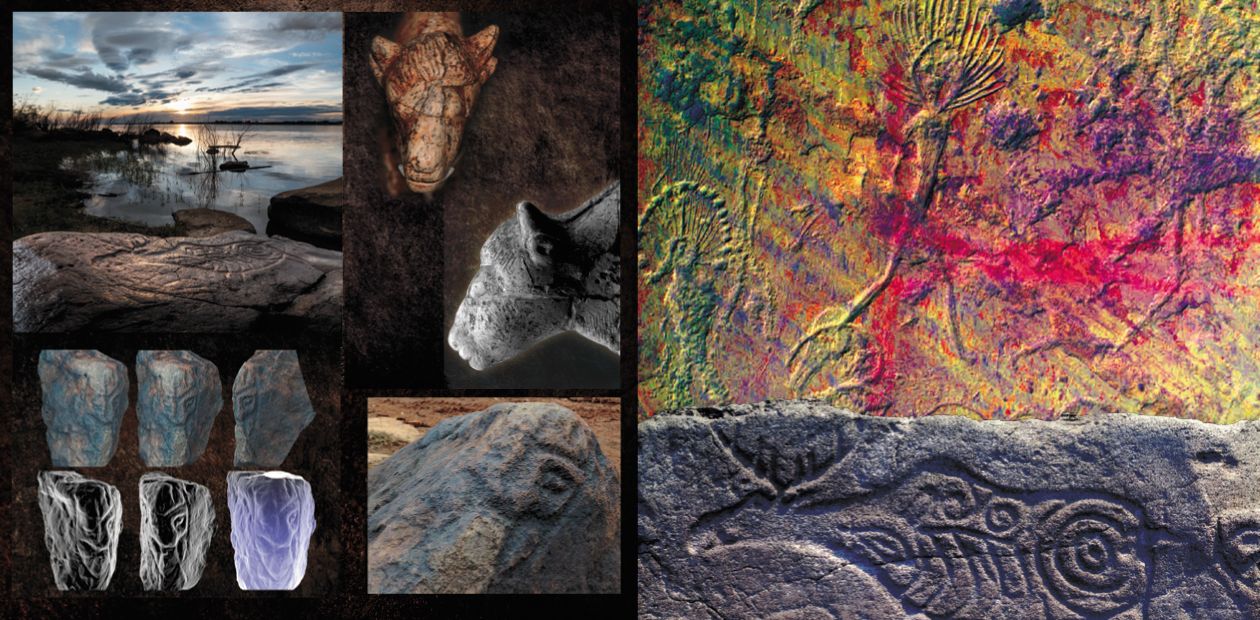A New Reality of Rock Art
Museums and art galleries appeared not too long ago, in contrast to the age-old human craving for artistic expression. The evidence is the numerous ancient masterpieces, such as rock carvings and reliefs, discovered all over the world under the open sky and inside caves. Having survived the millennia, these feats of human talent and skill often fall prey to the forces of nature and the vandalism of tourists. The issue of preservation of the unique “museum” exhibits can be partially addressed by modern research technology, which can give the items a new life in virtual reality as well as unravel the secrets of their creation
Samples of rock art are an integral part of cultural and historical landscapes. In Russia, they are found in many regions from the Kola Peninsula to Chukotka and the Khabarovsk Krai, in caves and niches, on vertical or horizontal rock planes and on single boulders. Each of the sites is unique in its thematic and stylistic features; the pisanitsas (this is how rock images are called in Siberia) of the Angara and Yenisei Rivers, the Ural and Altai Mountains, Transbaikalia and Yakutia reflect the artistic preferences, the cultural traditions and the very historical fates of the regions.
The stone’s ability to withstand time as well as its strength and invincibility have become a symbol ingrained in everyday consciousness as the antithesis of the fragility and evanescence of human lives. Reality can be different though. Regretfully, unorganized tourism often causes irreparable damage to fragile ancient “rock canvases.” Like any other works of art, unique image stones are a part of our cultural and historical space, and they deserve a most caring attitude.
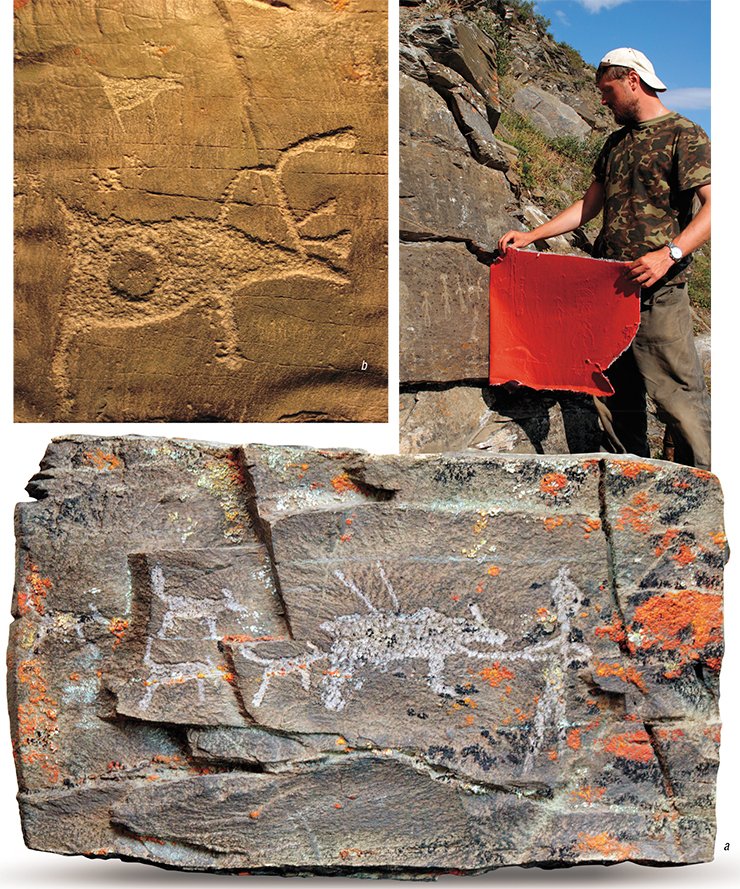
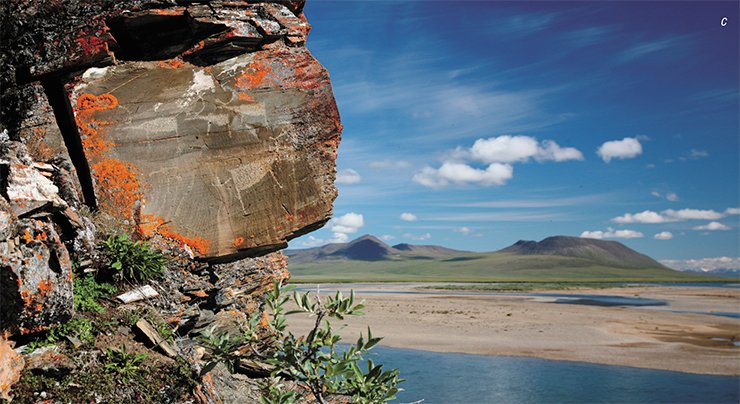
The load on the originals can be relieved by the so-called virtual tours. It should be noted that the entire history of the scientific study of rock art is associated with the development of techniques used to document and study these unusual objects, and the technological advances in the equipment used in expeditionary and laboratory studies has made it possible to record the features of ancient masterpieces in a new quality. Modern visualization techniques, high-quality photography, panoramas and 3D-models allow virtual tours to archaeological sites that are difficult to access in reality. Moreover, modern methods of documentation and analysis make it possible to obtain much more new data on known objects, including those that have long been kept in museums.
Restless boulders of Sikachi-Alyan
Since 2005, the rock art sites of Chukotka, the Khabarovsk Krai and other Russian regions have been part of a project implemented by the Petroglyphic Expedition of the Institute of Archaeology, Russian Academy of Sciences (Moscow). The project’s goal is to develop and test modern methods of documentation of rock art, which would allow one to look at and study these cultural items remotely, without damaging the monuments.
Today, researchers have an arsenal of contact and non-contact methods to identify petroglyphs and paintings. These methods include the use of silicone matrices to produce backup and expository positive molds of different materials, photogrammetry, gigapixel photography, reflectance transformation imaging (RTI), and imaging in different spectral ranges. Tarnished painted images are recognized using special programs to enhance the color contrast. All of these methods have enabled the monitoring of rock art samples to determine the rate of destruction and the threats to the preservation of open-air sites and to document new, previously unidentified petroglyphs on known objects.
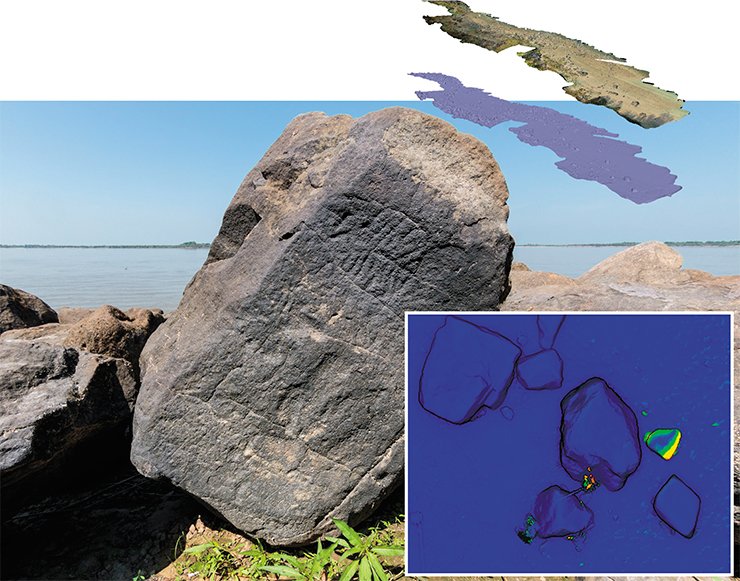
An example of these works is a comprehensive study of the impacts of a catastrophic flooding event on the petroglyphs of the Khabarovsk Krai. Here, on the banks of the deep Amur River, there is one of Russia’s largest rock art sites—Sikachi-Alyan. This site has nearly 120 boulders with as many as 450 petroglyphs dated from the Early Neolithic (13th to 10th millennia BC) to the Early Middle Ages (4th to 8th centuries AD). In 2013, this unique ancient monument was completely covered with water, which rose by almost eight meters.
The unprecedented flood took a heavy toll on the monument. However, apart from this event, every year the site experiences seasonal fluctuations of the water level in the Amur River and a severe impact of the ice flow. When ice breaks on the river with great vehemence, huge ice sheets thrust on one another, move and break apart. The ornate boulders on the river bank cannot resist the elements: the stones move, roll over, pile upon one another... And the unique petroglyphs, still visible a short while ago, disappear from the view...
The stones’ positions can be monitored by using photogrammetry. If one of the stones moves, a 3D model will be able to track not only the current position of the stone but also the direction of its movement. In this sense, a 3D model of Sikachi-Alyan can provide an effective tool for monitoring the restless basalt boulders during their seasonal movement.
Facing a mask
The hallmark of Sikachi-Alyan is its lichinas (after an obsolete Russian word lichina, which means ‘mask’ or ‘guise’), or stylized images of masks with anthropomorphic features. They are individual and diverse: the complex decorative design of the lichinas varies, without repeating itself, over the entire period of this petroglyphic tradition.
A notable feature in the artistic tradition of Sikachi-Alyan is that ancient artists created their lichinas on the edges between the faces of a stone, and their images have a relief and texture that virtually defy reproduction on planar copies. Here, photogrammetry offers a helping hand again: the items can be reproduced as 3D models. Moreover, the textured models of the shell provide more objective evidence as to which lines were made thousands of years ago by the hand of an artist and which ones are natural features of a given rock.
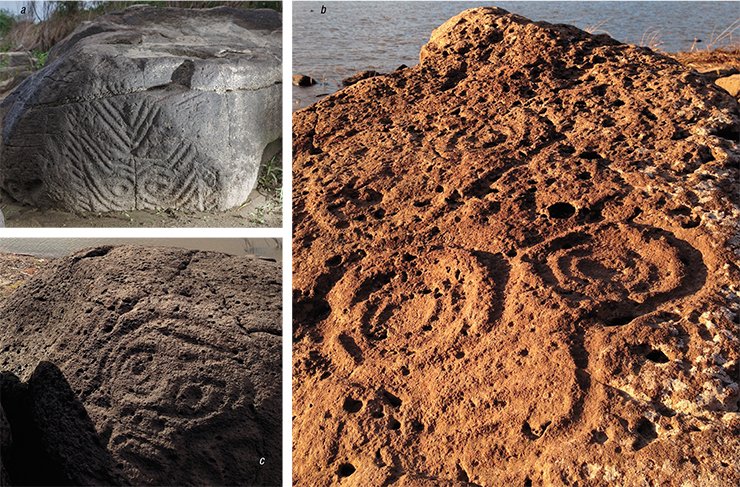
The central object of the Sikachi-Alyan sanctuary is an amazing rock whose different planes bear different images. To see them all, you need to walk around the rock and see it from different angles. However, now you can do it without taking a long trip, simply by rotating a 3D model of the monument at the website http://www.archaeolog.ru/index.php?id=400.
Particularly captivating is the central image of an elk, whose body is ornamented with swirls and curved lines (see the photo on pp. 108-109). This design of the animal’s body bears more than just a decorative function. On the vertical edge between the faces of the stone, there is a human figure with a clearly depicted rib cage. Like this human figure, the elk’s image is an example of the so-called X-ray style.
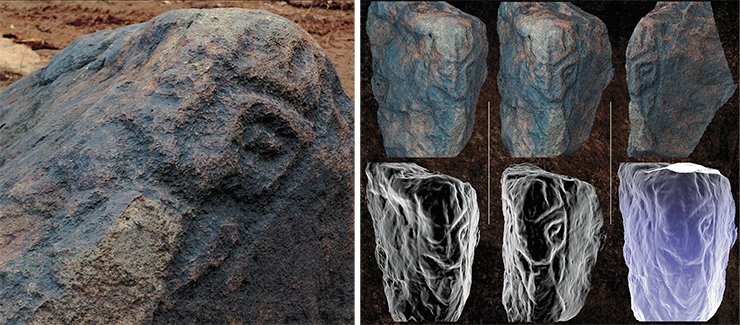
The “transparency” of these images is associated not only with the specific aesthetics but also with the idea that the skeleton is the most durable part of a living being because bones can best withstand the ravages of time. It is no coincidence that traditional beliefs of various natios throughout the world share the idea that humans and animals are reborn to a new life, starting with the bones.
Tools and techniques
The weather dependence of archaeological field studies and the need to catch the right light largely increase the labor costs of the works on rock art sites. Reflectance transformation imaging (RTI) can be of great help here because this method allows one to select, from a variety of frames, the best one to identify details, which corresponds to the most favorable oblique illumination. Excellent results were obtained using models based on photogrammetric imaging of a rock surface relief: they provide reliable information on how the ancient artist was using the rock relief.
Exciting findings were also made by studying technological features of petroglyphs, i. e., identifying traces left by ancient tools in order to find whether the latter were made of stone or metal, to reveal the shape of the working edge, and to understand the operations used by the artist. In recent years, there have been advances in these studies on rock art monuments in Siberia and the Far East due to the use of experimental trace analysis.
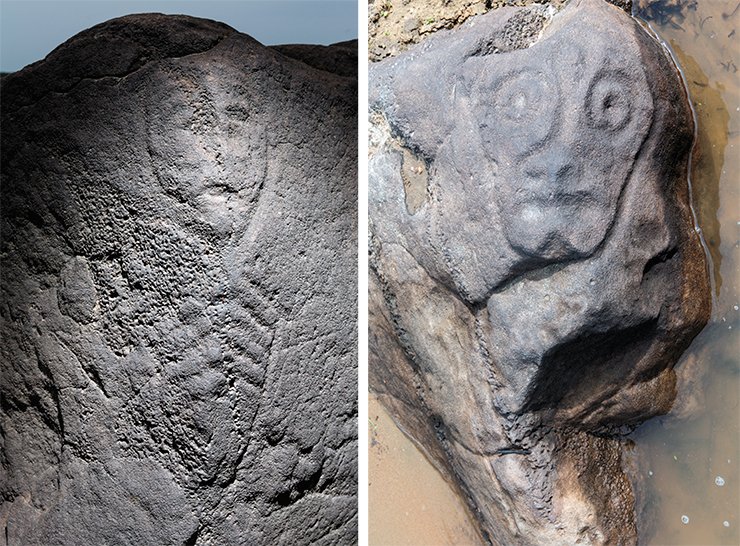
Researchers were able to determine the morphological features of the tools and identify the techniques used by ancient artists by carrying out a series of experiments at rock art sites to reveal traces of picketage (pecking). However, picketage is only one, albeit the most common, way of creating petroglyphs, which can also be made by abrading, scraping, carving and other techniques.
The comparison of the samples obtained in the experiments with ancient images proved to be very effective. In some cases, researchers were able to trace signs of the use of one set of techniques and a corresponding set of tools, which can suggest the development of stable technical means within the various traditions of rock art.
Eventually, the observations on the shape of various traces were systematized so that researchers can now confidently distinguish between traces left by different tools. It turned out that a stone tool would wear out faster and a part of it would chunk out; therefore, the traces left by this tool would also change their shape. Metal items are generally more stable; therefore, the traces left by these tools are deeper, have a characteristic narrow inlet and are more homogeneous in shape.
Colors of Kapova Cave
However, images carved in stone are not the only samples of rock art. There are also paintings, although the pigments with which they were made could differ greatly in texture—dry chalk, water-diluted suspensions, viscous masses, etc. In total, there are about 300 decorated caves with stone-age images in the area from the southern tip of the Iberian Peninsula to the Ural Mountains. The most important and the most eastern monument associated with the art of “painting in the dark” is Kapova Cave (Shulgan-Tash) in the south of the Ural Mountains. This cave is located at a large distance of 4,000 km from the main cluster of caves with Paleolithic paintings.
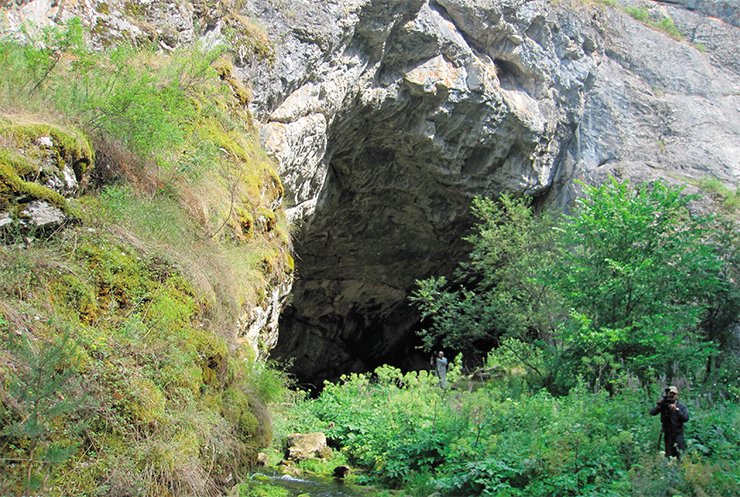
The Palaeolithic layer of this monument was radiocarbon dated as 13,900 to 16,710 years old. Chunks of rock with image fragments, which were found in the cultural layer, and the stylistics typical of the Upper Paleolithic cave art give a link between the time interval of creating the images and the stages in the development of the cave by Palaeolithic man.
The paintings, which are localized on the medium (the Cupola Hall, the Hall of Signs and the Hall of Chaos) and top (the Hall of Drawings) tiers of the cave, were made mostly with red paint. The variety of shades, the ways how the ancient artists used the textures of walls in different halls, and the presence of caches with paint—all this makes it possible to identify the specific formulations and the time of production of different pigments and to find the sources of raw materials for the paints. The study of the Upper Paleolithic rock art and paintings in Kapova Cave is conducted by the Paleoart Center, Institute of Archaeology, Russian Academy of Sciences (IA RAS), in collaboration with Vladislav Zhitenev, Head of the South-Ural Archaeological Expedition of Moscow State University. The researchers use a range of archaeological and natural-scientific methods.

As a result, they have found that the basis of the pigment is hematite, a widespread iron mineral used as a component of red paint or in red ocher. The size of the crushed pigment particles varies in different formulations, which affects the paint color, and ancient artists were apparently well aware of this fact. They consciously preferred rock surface areas that contrasted in shade or had a specific texture.
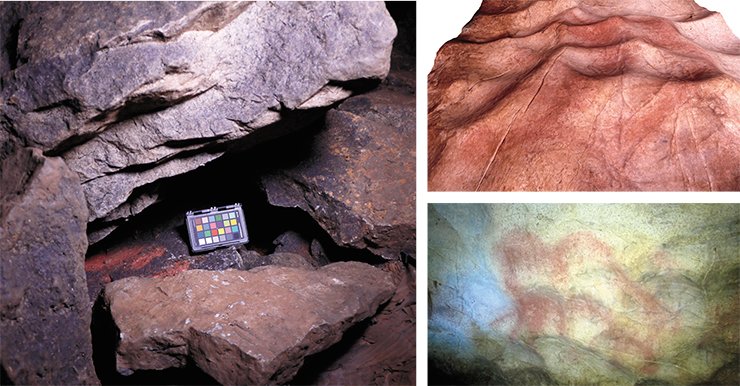
The images in the Hall of Drawings are characterized by the use of textured wall surfaces and light-red ocher with small (less than one micron) hematite particles mainly on rock surface. In the middle tier of the cave, there are also images made with a cherry-colored paint, which contains large hematite crystals. In the Hall of Chaos, the artists used, as a paint, a typical mixture of coarse-grained hematite and coal. Many of the paintings in this hall were placed over travertine formations; the artists preferred lighter areas covered with calcite layers, which stand out against the gray-brown surface of the wall.
Red pigments played an exceptional role in the life of primitive man, as evidenced by the many caches with paint in the halls of Kapova Cave. The large amount of stored and specially prepared pigment indicates that it was likely used not only for the decoration of the roof and walls of the cave but also for other objects, possibly associated with rituals.
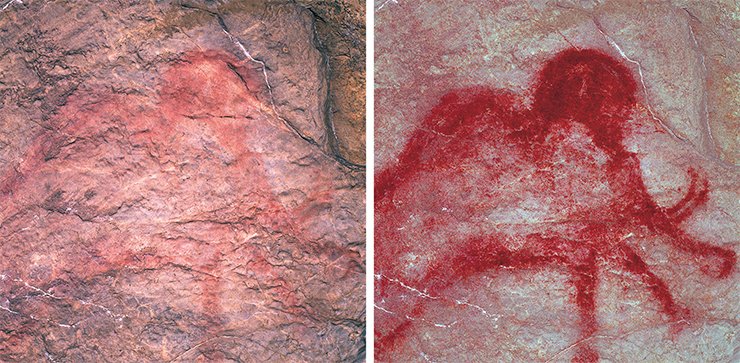
Where did the material for the production of the paints come from? The hypothesis that one of the sources of raw materials was the outcrops of iron ore in the immediate vicinity of the cave was later confirmed experimentally. The methods of Raman spectroscopy and electron microscopy with X-ray microanalysis were used to determine the composition of the brown ore nodules containing goethite, anatase, lepidocrocite and clay minerals. The paint must have been prepared by first burning this ore on a fire and then pulverizing it. The ore was studied at the Kurchatov Institute (Moscow) by thermogravimetry and analysis of phase composition of the samples. It was found that when the ore is heated, the goethite dehydrates to form hematite. The study also confirmed the mineral composition of the hematite samples.
Paleolithic melody
A fresh perspective on how the Upper Paleolithic works of art—both rock images and small objects of plastic art—were created comes from modern methods of analysis and from photography with very high resolution and in various spectral bands. Thus, in 2001, an expedition organized by the IA RAS and led by Khizri Amirkhanov, RAS Corresponding Member, at an ancient town of Zaraysk near Moscow discovered a figurine of a female bison in a Paleolithic layer at the walls of the local kremlin.
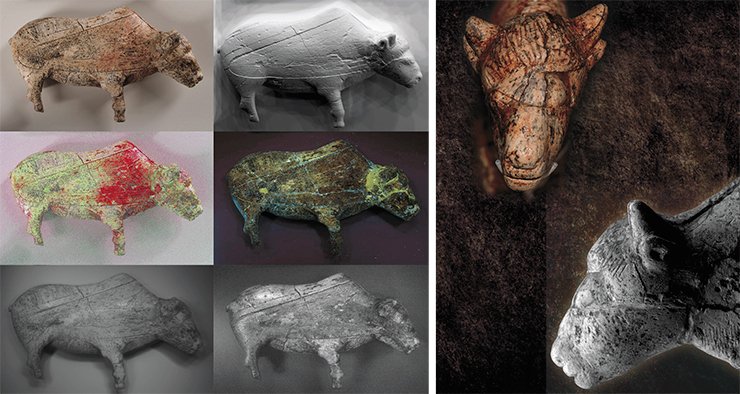
This ancient masterpiece sculpted from mammoth ivory was lying in a cache pit. The bison’s right side was painted intensive red; its left side had deep holes; two legs were broken. Further studies showed that these defects must have appeared about 20,000 years ago during ritual manipulations. The defects are likely to be traces of ancient hunting magic, an attempt to succeed in hunting real prey by hitting the animal’s image.
There were also traces of a black substance on the bison’s sides, but it was unclear whether they occurred before the animal was hidden in the cache on a red ocher spot, or later. An RTI study confirmed that the traces of the black substance were left later.
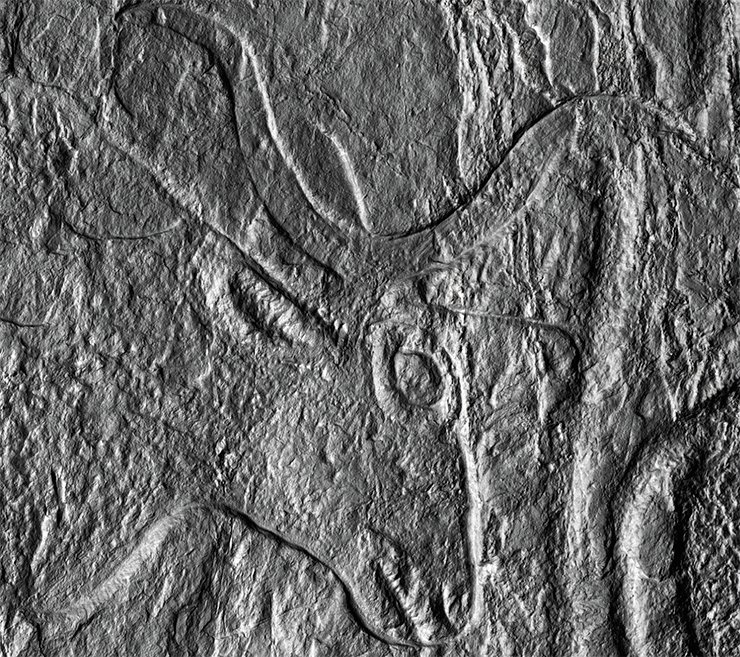
In recent years, new research approaches to materials stored in museums around the world have opened many previously unknown pages of the past. For instance, researchers have found the missing pieces of the famous 40,000-years-old Lion Man sculpture of Hohlenstein-Stadel Cave (Germany). Importantly, this discovery was made not by further excavations, but inside the museum of the University of Tübingen!
Moreover, researchers working in museums have been able to restore—literally from tiniest particles—ancient musical instruments. They came back to life because of the careful work with the archaeological collections from the monuments of the south-western Germany: numerous pieces were put together to turn into flutes! The reconstruction of musical instruments made from swan and vulture bones and from mammoth tusks gave us a unique opportunity to hear the amazing sounds that accompanied the life of Paleolithic man.
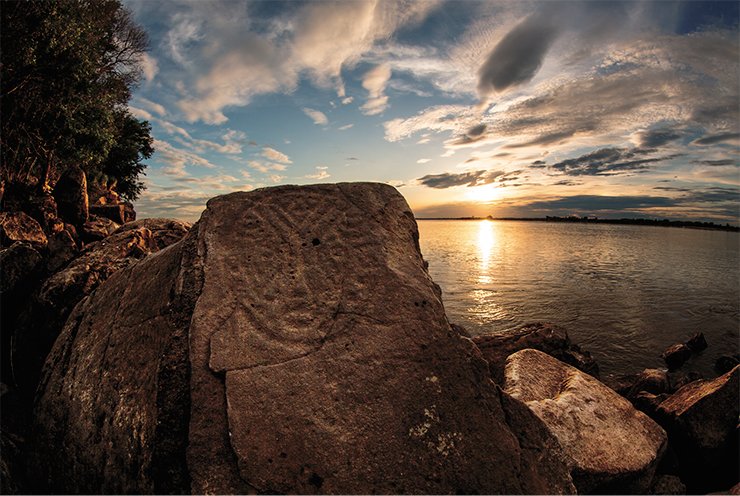
Archaeology is an amazing science where researchers can make discoveries not only in the field during excavations but also by studying long-known monuments.
In 1978, a young Siberian researcher Vyacheslav Molodin, now a full member of the Russian Academy of Sciences, together with a Moscow archaeologist Aina Pogozheva, discovered and described the Tengin stele, an outstanding artifact also known as a “plate from Ozernoe” (Altai Mountains), which dates back to the middle of the second half of the second millennium BC. The stele, which now greets visitors at the entrance of the Institute of Archaeology and Ethnography, Siberian Branch, Russian Academy of Sciences (IAE SB RAS, Novosibirsk), shows a caravan of hoofed animals, some of whom are tied by their horns to vertical poles. The animals are depicted with exceptional skill. Image themes like this one, which illustrate archaic mythologems, are likely to have come from Southwest Aisa. The beautiful ancient artifact was studied using modern photography to reveal technical details, invisible to the naked eye, which recount the story of how it was made.
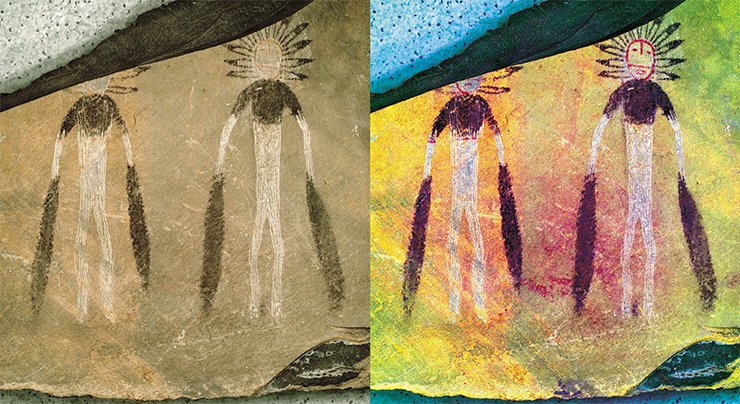
Another challenge for archaeologists is to determine the composition of ancient pigments, identify ancient paint binders and make an accurate reconstruction of original colors that have changed over time. This research area has a huge potential, which can only be unlocked by taking an interdisciplinary approach and using the entire range of possibilities of modern photography. The works by our colleague Alexander Pakhunov have made a substantial progress in this area. The next landmark is the study of the remarkable polychrome Karakol plates from the collection of the IAE SB RAS Museum, which are a striking example of “symbolic destruction” of works of art belonging to a different culture.
These and other similar problems of archaeology will be a focus of the joint Russian–French laboratory named Multidisciplinary Studies of the Primitive Art of Eurasia. Directed by the world-renowned scientists Vyacheslav Molodin and Jean-Michel Geneste, the laboratory was set up in 2015 by Novosibirsk State University and the University of Bordeaux.
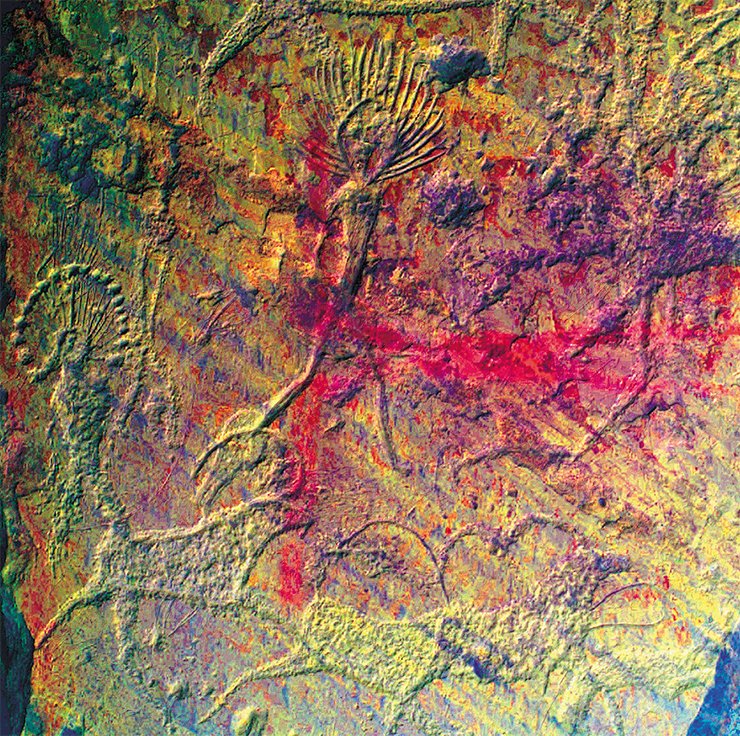
Studying the works of ancient art by modern methods helps researchers better evaluate the place of these works in the system of primitive culture and identify technical and technological features of their creation. Moreover, these studies can reveal the hand of a true artist! Works of ancient art most open a fascinating window into the world of the primitive. These works are a key to understanding that it is the ineradicable creativity of human beings rather than the abundance and sophistication of material goods that makes us human.
References
Amirkhanov Kh. A. and Lev S. Yu. Bison figurine from the Zaraysk site: archaeological and symbolic aspects of the study // Rossiiskaya Arkheologiya. 2003. N 1 [in Russian].
Amirkhanov Kh. A. and Lev S. Yu. Palaeolithic works of art at the Zaraysk A site // Issledovaniya paleolita v Zaraiske. 2000–2005 gg. (Palaeolithic Studies at Zaraysk. 2000–2005). Moscow: Paleograf, 2009 [in Russian].
Devlet E. G. Al’tamira: u istokov iskusstva (Altamira: At the Origins of Art). Moscow: Aleteya, 2004 [in Russian].
Devlet E. G. and Devlet M. A. Mify v kamne. Mir naskal’nogo iskusstva Rossii (Myths in Stone: Russia’s World of Rock Art). Moscow: Aleteya, 2005 [in Russian].
Conard N. World Heritage and the evolution of modern human behavior // Human Evolution: Adaptation, Dispersals and Social Developments (HEADS). World Heritage papers. UNESCO, 2011. V. 29.
Cook J. The Ice Age Art: arrival of the modern mind. The British Museum Press, 2013.
Kubarev V. D. Zagadochnye rospisi Karakola (Mysterious Paintings of Karakol). Novosibirsk: Sib. Otd. Ross. Akad. Nauk, 2013 [in Russian].
Molodin V. I. and Pogozheva A. P. A Plate from Ozernoe (Gorny Altai) // Sov. Arkheologiya. 1990. N 1. P. 167–177 [in Russian].
Molodin V. I. and Cheremisin D. V. Drevneishie naskal’nye izobrazheniya ploskogor’ya Ukok (Ancient Rock Images of the Ukok Plateau). Novosibirsk: Nauka, 1999 [in Russian].
Okladnikov A. P. Petroglify Nizhnego Amura (Petroglyphs of the Lower Amur). Leningrad: Nauka, 1971 [in Russian].
Pakhunov A. and Zhitenev V. Results of natural science studies of a paint mass congregation: new data on the formulations of paints in Kapova Cave // Stratum plus. Arkheologiya i kul’turnaya antropologiya (Stratum Plus. Archaeology and Cultural Anthropology). N 1. St. Petersburg, 2015. P. 125–135 [in Russian].
Pakhunov A. S. and Lev S. Yu. Integrated research photo imaging of the bison figurine found at Zaraysk: preliminary results // Kratkie soobshcheniya Instituta arkheologii (Brief Communications of the Institute of Archaeology), N. 241. Moscow, 2015 [in Russian].
The author thanks A. I. Georgievski, E. Girya, A. Kochanovich, A. Laskin, A. Pakhunov and her other colleagues for long and fruitful cooperation
This work was supported by the Russian Foundation for Humanities (projects 15 01-00240 and 16-01-18104)


